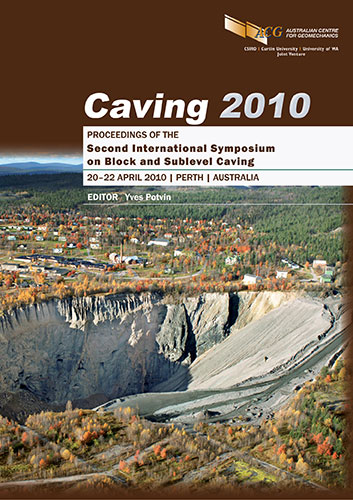A discrete fracture network based approach to defining in situ, primary and secondary fragmentation distributions for the Cadia East panel cave project

|
Authors: Rogers, S; Elmo, D; Webb, G; Catalan, A |
DOI https://doi.org/10.36487/ACG_rep/1002_29_Rogers
Cite As:
Rogers, S, Elmo, D, Webb, G & Catalan, A 2010, 'A discrete fracture network based approach to defining in situ, primary and secondary fragmentation distributions for the Cadia East panel cave project', in Y Potvin (ed.), Caving 2010: Proceedings of the Second International Symposium on Block and Sublevel Caving, Australian Centre for Geomechanics, Perth, pp. 425-439, https://doi.org/10.36487/ACG_rep/1002_29_Rogers
Abstract:
One of the most critical elements in pre-caving assessment process is determining the likely distribution of rock mass fragmentation, with the impact of poor or unexpected fragmentation upon cave operations being significant. For a number of years it has been recognised that discrete fracture network (DFN) tools could assist in the fragmentation assessment, primarily through providing a better description of the pre-caving in situ fragmentation distribution. To date the evaluation of primary and secondary fragmentation has been mostly carried out using alternative methods based on engineering principles and practical experience. More recently, synthetic testing of relatively small DFN models has been proposed to assess fragmentation mechanisms. However, it is argued that neither of these approaches can fully capture the broader heterogeneity of the rock mass, drawing on only a limited portion of the rock mass characterisation data. Recent work has demonstrated the sensitivity of rock mass fragmentation to the volumetric fracture intensity property P32 and the importance of determining the critical intensity value at which the transition from intact massive rock mass to kinematically mobile rock mass occurs. To address these issues, the authors have developed an approach that has at its core the development of a full scale DFN model description of fracture orientation, size and intensity built up from all available geotechnical data. The model fully accounts for a spatially variable description of the fracture intensity distribution. Primary fragmentation analysis is undertaken by using a DFN based rule approach, which draws from an explicit numerical simulation of fracture mechanisms to characterise stress induced fracturing within a given rock mass. Direct modelling of secondary fragmentation related to mining-induced stress and comminution of caved material in the broken ore column poses significant challenges as large-scale discrete modelling (including fracturing) of processes requiring a centimetre-scale mesh discretisation becomes computationally prohibitive. To obviate this problem, this paper introduces a method to assess secondary fragmentation based on a probabilistic analysis by combining the DFN derived primary block volume distribution with micro-defect intensity data to derive a probability of block degradation during caving.
References:
Catalan, A., Suarez, C., Barrera, V. and Qudraturrahman, I. (2008) Cadia East Underground Project Pre-Feasibility Study, Geotechnical Report, Newcrest Mining Limited Internal Document.
J. Carter, A. Dyskin and R. Jeffrey (eds), 16–19 September 2009, Perth, Australia, Australian Centre for Geomechanics, Perth, Vol. 2 – Fundamental and Petroleum, pp. 3–16.
Dershowitz, W.S. and Herda, H.H. (1992) Interpretation of Fracture Spacing and Intensity, in Proceedings 33rd US Rock Mechanics Symposium, Santa Fe, New Mexico, pp. 757–766.
Dershowitz, W., Lee, G., Geier, J. and LaPointe, P.R. (1998) FracMan: Interactive discrete feature data analysis, geometric modelling and exploration simulation, User Documentation, Golder Associates Inc., Seattle, Washington.
Elmo, D. and Stead, D. (2009) An integrated numerical modelling - discrete fracture network approach applied to the characterisation of rock mass strength of naturally fractured pillars, Rock Mechanics and Rock Engineering,
Golder Associates (2009) FracMan 7.20, FracMan Technology Group, Golder Associates Inc., Seattle, Washington.
Klerck, P.A. (2000) The finite element modelling of discrete fracture in quasi-brittle materials, PhD thesis, University of Swansea, UK.
Laubscher, D.H. (1994) Cave Mining – State of the Art, Journal of the South African Institute of Mining and Metallurgy, Vol. 94, No. 8, pp. 270–293.
Oracle (2009) Crystal Ball software, viewed 5 December 2009, www.crystalball.com.
Pierce, M., Cundall, P., Potyondy, D. and Mas Ivars, D. (2007) A synthetic rock mass model for jointed rock, in Proceedings 1st Canada–US Rock Mechanics Symposium, Vancouver, Vol. 1, pp. 341–349.
Rockfield Software (2009) ELFEN Version 4.3.3, Swansea, UK.
Rogers, S., Elmo, D., Beddoes, R. and Dershowitz, W. (2009) Mine scale DFN modelling and rapid upscaling in geomechanical simulations of large open pits, CD-ROM only, Day 2, 11 p.
Rogers, S.F., Moffitt, K.M. and Kennard, D.T. (2006) Probabilistic Tunnel and Slope Block Stability analysis Using Realistic Fracture Network Models, in Proceedings 41st US Symposium on Rock Mechanics: 50 Years of Rock Mechanics — Landmarks and Future Challenges, Golden, Colorado, paper 06-1052.
Wang, X. (2006) Stereological Interpretation of Rock Fracture Traces on Borehole Walls and Other Cylindrical Surfaces, PhD Thesis, Virginia Polytechnic Institute and State University.
Yan, M. (2008) Numerical modelling of brittle fracture and step-path failure: from laboratory to rock slope scale, PhD thesis, Simon Fraser University, Vancouver, Canada.
Yu, J. (1999) A contact interaction framework for numerical simulation of multi-body problems and aspects of damage and fracture for brittle materials, PhD thesis, University of Wales, Swansea, UK.
© Copyright 2025, Australian Centre for Geomechanics (ACG), The University of Western Australia. All rights reserved.
View copyright/legal information
Please direct any queries or error reports to repository-acg@uwa.edu.au
View copyright/legal information
Please direct any queries or error reports to repository-acg@uwa.edu.au